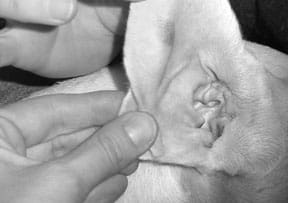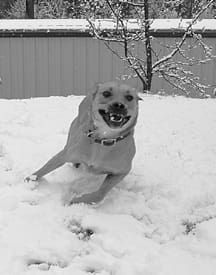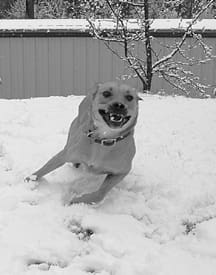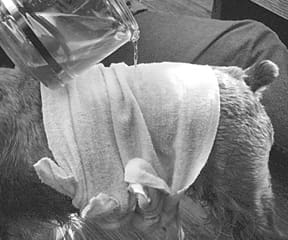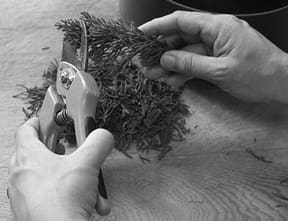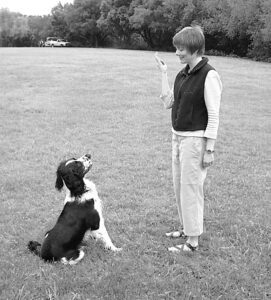by C.C. Holland
A few years ago, I underwent extensive knee surgery. Thanks to a skilled doctor, a supportive husband, and an Internet message board comprised of people who’d either undergone or were about to embark on similar procedures, I made it through with both my physical and mental health intact.
A couple of months ago, my dog, Lucky, decided to follow in her mom’s footsteps by tearing a ligament in her knee and undergoing her own surgery.

Before she went under the knife, I researched everything I could about the procedure. As I scoured the Web, it occurred to me that if there were message boards and online support groups for humans with knee injuries, maybe there’d be an equivalent for canines and their owners.
Sure enough, I found Orthodogs, a free group (set up through a Yahoo! service) that provides support, information, and advice to owners with dogs facing orthopedic problems. And then I discovered it was only the tip of the iceberg.
There are dozens of online groups aimed at dog owners out there, covering a wide range of topics – disabled dogs; dogs with cancer; dogs who have behavioral and training issues; and even grieving the loss of a pet. Groups range in size from a few dozen people to thousands; thanks to the Web, many include members from all over the globe. Most are free – and the criteria for membership are simply time, interest, and an Internet connection. To communicate, members “post” messages via interactive tools and can even contact each other directly through e-mail.
Can a virtual community of people you’ll probably never meet really help an owner cope with a dog’s problems? Yes, say mental-health professionals.
“Finding like-minded people who understand exactly what you’re feeling and who can respond to you basically 24 hours a day is very helpful,” says Darlene Mininni, Ph.D., author of the forthcoming book, The Emotional Toolkit, and an expert in coping strategies.
In addition, says Dr. Mininni, the act of typing out your messages provides a therapeutic outlet.
“That’s an added bonus, because writing about your feelings helps you make sense of them,” she says. “It’s the same benefit of writing in a journal – and there are tons of studies that demonstrate how doing that can improve your feelings.”
Betty Carmack, a professor of nursing at the University of San Francisco, has been running a pet-loss counseling group in the Bay Area since 1982. While her group is one that meets physically, rather than virtually, she says that any kind of support network can be helpful to owners weathering a crisis with their pets.
“It’s so important for people to find some kind of validation for what they’re feeling, whether it’s online, one-on-one counseling, books, or support groups,” she says. “Now there are wonderful resources, and people don’t have to get through it alone.”
Benefits of community
One benefit of online groups commonly mentioned by participants is the feeling that they become part of a community or family. Sharing a common challenge can be a powerful bond.
Andrea Barnhart of Albany, New York, found the Canines in Crisis cancer board when her dog, Patches, began battling lymphoma and leukemia. “These people truly understand what I’m going through because they are experiencing the same emotions,” she says.
Brenda Osbourne of Owasso, Oklahoma, joined the Orthodogs group when one of her seven dogs required knee surgery.
“It was like being brought into a big extended family, and the warmth and the caring was so heartfelt,” she says. “It felt so good to be sharing what is a very frightening journey with so many other people who had not only been through it but were so willing to help you get through it.”
Osbourne became so involved in the group that she became an official moderator – a member with administrative rights who polices the message posts, keeping an eye out for people who ignore the basic rules (no profanity, no personal attacks, etc.) or have less-than-altruistic agendas, such as pushing commercial “miracle cures.” Osbourne now spends a good part of each day reviewing posts and answering questions, squeezing out the time despite her demanding career in cancer research.
In some cases, the feeling of family extends beyond the computer. In March, a group of people on the Orthodogs message board pooled resources to help a financially challenged member afford surgery for her dog. And the members of a group known as Deaf Dogs hold yearly get-togethers around the country.
“I thought (that) was amazing,” says Monica Mansfield of Ancramdale, New York, who joined the group two years ago when she became interested in adopting a deaf puppy. “It is wonderful to get to meet some of the friends you’ve made online in person. I’ve been to two different Deaf Dog picnics and plan on attending many more.”
No stupid questions
Many newcomers can be hesitant about posing questions on these online boards, worrying that their inquiries are inane or redundant with earlier message posts. But most find their concerns to be unfounded.
“I wondered what they would think of another newbie asking the same dumb questions they’d heard a million times,” says Tamie Adams, an Alabama dog owner who found the Orthodogs group while researching ligament repair options for Brodie, one of her two Rhodesian Ridgebacks. “So I introduced myself and then proceeded to read, and read, and read, without posting very often. (But) as I became familiar with the other people who posted, I was amazed at how warm and caring they were to everyone.”
“I think it is a continual ‘passing of the torch’ in online groups,” says Mansfield. “Almost everyone starts as a newbie and is there for answers to their questions and to learn from the people who have more experience. Then they start becoming comfortable enough to start answering other peoples’ questions.”
Dr. Mininni says this give-and-take process can be very helpful to group participants.
“It’s important that you feel like you matter to others,” she says. “If you are both getting advice and giving it, and people are appreciative of that, those are multiple ways you’re helping your psyche.”
Advice and research
In addition to seeking the mental and emotional support offered by these groups, many owners also use them to compare notes, discuss new research and information, and give advice. Some turned to the groups in frustration after their veterinarians fell short in providing them details, or when they believed their vets couldn’t or wouldn’t provide information about adjunct therapies such as herbal remedies.
“Good grief, my surgeon didn’t give us squat!” says Adams. “I had researched herbs and supplements, but I had to get all the dosage information from (the group). I also got all of my pre-op and post-op information from the things that other people’s vets had told them.”
Paola Ferraris, of Milan, Italy, who also serves as a moderator for the Orthodogs group, says that people often appreciate hearing about the range of issues that can affect dogs before and after surgery.
“Comparing notes and reactions of the dogs post-op and pre-op can be useful,” she says. “In some cases, issues discussed – such as pros and cons of (a certain) clinic, or breed-specific (problems) that vets rarely mention – have helped people discuss all options with their surgeons, or made others aware of potential reactions and side effects of treatments.”
Members may also suggest alternative therapies or procedures that other owners hadn’t considered or even known about. “I’d have to say that if I weren’t part of this group I probably would never have explored holistic approaches or using natural herbal remedies in certain cases,” says Osbourne.
Indeed, reading posts on the Orthodogs board before Lucky’s surgery prepared me for some of the physical challenges that could plague her afterward, including constipation – something our vet didn’t mention despite our extensive consultations. It also clued me in to the potential of horsetail grass as a supplement to help speed bone healing.
Sometimes, there’s so little data out there that only talking to someone facing the same challenges can help. Monica Mansfield says the Deaf Dogs board was an invaluable resource for obtaining real-world information instead of theoretical feedback.
“There are so many things that I learned from the group that you can’t learn anywhere else,” she says. “Many vets don’t have much deaf-dog experience, since deaf puppies are routinely euthanized or culled. Also a lot of the parent breed clubs are against the placing of deaf dogs or puppies, so there is not much information to be gotten from them.”
The information provided can be more than anecdotal. It’s not unusual to find message board members posting links to recent veterinary journal publications, studies, press releases, or newspaper and magazine articles. That’s yet another way members can deepen their understanding of the challenges they and their dogs are facing.
A few drawbacks
Despite the benefits they offer, message boards must be consulted with prudence. The biggest risk of using message boards is using poor information and putting your pet at risk. Few people deliberately post incorrect suggestions, but they may not get all their facts straight. In addition, the people who are the most prolific posters aren’t necessarily the ones with the best information, which can make it tough to decide when to accept ideas and when to break out that proverbial grain of salt.
“New people don’t know who to listen to,” says Osbourne. “With a group the size of Orthodogs, new people tend to get a lot of responses and since they’re usually just beginning their journey, they don’t know how to sort out the good advice from the bad. I think it can be a little overwhelming sometimes.”
If you obtain any medical advice or information from a message board, run it by your vet before putting it into practice. Herbs and supplements may interfere with medications or affect dosages. Changing a diet can stress an ill dog if it’s not done correctly. And rehabilitation protocols vary widely. Your vet might have a very good reason for, say, allowing your dog a short daily walk post-surgery while requiring that another dog remains completely immobilized.
It’s also wise to verify what you read through independent, reliable sources rather than taking one person’s posts as gospel. When I read a recommendation about horsetail grass as a bone-healing supplement, I verified that claim through Drug Digest (drugdigest.org), a consumer health and drug information Web site; the Food and Nutrition Information Center (nal.usda.gov/fnic/index.html) at the National Agricultural Library; and Greg and Mary Tilfords’ definitive reference, Herbs for Pets.
Some of the problems with online message boards are more social than serious. One common complaint is that it’s sometimes difficult to interpret the emotions behind the typed word. “The worst drawback is not being able to get the ‘tone’ behind the posts,” says Mansfield. “It’s very hard to tell if someone is being sarcastic, serious, kidding, or angry just by their words. I think that a lot of misunderstandings happen that way, on all the groups.”
“It’s e-mail, which tends to be a very impersonal way to communicate,” agrees Osbourne. “Messages can be misinterpreted or somebody’s sense of humor doesn’t quite come through and it can cause problems.”
Also, you should be aware that your vet may not be completely supportive of your involvement in message boards, especially if what you read conflicts with his advice or protocols.
“I think some vets consider the list a big pain,” says Ferraris, “(because) people start comparing prices for surgery, rehab options, therapies, and post-op protocols.”
Maximize the resource
The best way to approach message boards is to view them as research and support tools, rather than replacements for your veterinarian. Don’t accept at face value the information you read, and keep your vet in the loop at all times when it comes to medical decisions, including complementary and alternative options. Talk to your vet about message-board questions and concerns with a collaborative mindset, rather than thinking combatively.
“I’ve told my vet I participate in the group, (and) she supports it,” says Adams. “I just tell her my game plan after weighing all the input from the group and my own research, and get her feedback.”
And don’t discount the value of the boards’ social support when you’re dealing with a crisis.
“Numerous studies show that feeling connected to others and using that care when needed can decrease sadness, anxiety, loneliness, and feelings of helplessness,” says Dr. Mininni.
“I’m so thankful for the message boards,” says Barnhart. “There have been suggestions made by other visitors that have made a big difference for Patches . . . medicines, supplements, books to read, diets, you name it. And the support and comfort that I have gained have been amazing.”
-C.C. Holland is a freelance writer in Oakland, California, and regular contributor to WDJ. Her dog, Lucky, is recovering well from TPLO surgery.







